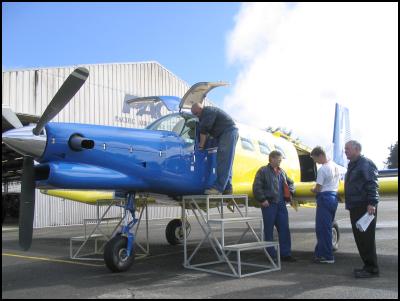Another First For Pacific Aerospace Corporation
News Release
April 7, 2004

CAPTION: Pacific Aerospace
Corporation assembly manager Jim Barry (right) oversees
assembly workers (from left) Jason Roe, Derek Lewis and Mark
Runciman as the Australian-bound PAC 750XL is given a final
inspection before departing Hamilton today.
Hard on the heels of American Federal Aviation Administration certification for its PAC 750XL aircraft, Pacific Aerospace Corporation has received certification for the same aircraft from the Australian aviation authorities.
Type Acceptance certification from the Australian Civil Aviation Safety Authority was received for the PAC 750XL within days of the FAA certification last month. The Australian certification accepts and recognises the NZCAA Type Certificate which effectively means the company can market its flagship aircraft in Australia.
The first Australia-bound PAC 750XL departed Hamilton today for its new home at Sydney Skydive, in New South Wales.
The first passenger aircraft to be designed and manufactured in New Zealand, the PAC 750XL is also believed to be the first aircraft built in the last 25 years specifically to target the adventure parachuting market.
Pacific Aerospace Corporation’s managing director, Brian Hare, says it’s very appropriate the first PAC 750XL sold into Australia is going to a skydiving operator. However, he says, the PAC 750XL is a genuine multi-purpose plane whose uses go far beyond parachuting.
“This aircraft is ideal for carrying cargo, reconnaissance, sightseeing, commuting, mineral exploration and medical and mineral use,” says Hare. “And this is reflected in the enquiries we are receiving.”
Hare says since the FAA certification, the PAC 750XL has attracted worldwide interest. The company’s website is taking up to 5000 hits a day.
“We are starting to convert options into orders with confirmations and deposits paid on five new aircraft as a direct result of the FAA certification. Into Australia alone, we are currently negotiating the sale of another three aircraft.”
Hare predicts that within one year his company could have aircraft in seven different markets including Europe, US, Australia and New Zealand. Three aircraft already under construction are earmarked for Switzerland, the UK and the US.
At $1.7m per plane, Pacific Aerospace Corporation is sitting on export orders in excess of $440m over the next 10 years.
To cope with the added workload, the company has taken on 40 new permanent employees since November – the latest being all 10 students who graduated in March from the Waikato Institute of Technology’s Fabrication Foundations course.
The official FAA Certificate was presented to Pacific Aerospace Corporation at the FAA Asia Pacific Bilateral Partners Dialogue Meeting in Wellington last week.
END


 Engineering New Zealand: NZ Building System Needs Urgent Improvement
Engineering New Zealand: NZ Building System Needs Urgent Improvement GNS Science: Bioshields Could Help Slow Tsunami Flow
GNS Science: Bioshields Could Help Slow Tsunami Flow Transport and Infrastructure Committee: Inquiry Into Ports And The Maritime Sector Opened
Transport and Infrastructure Committee: Inquiry Into Ports And The Maritime Sector Opened Netsafe: Netsafe And Chorus Power Up Online Safety For Older Adults
Netsafe: Netsafe And Chorus Power Up Online Safety For Older Adults RBNZ: 10 Cent Coin With King Charles III Image Now In Production
RBNZ: 10 Cent Coin With King Charles III Image Now In Production NZALPA: Safety Improves From AKL Incident Learnings
NZALPA: Safety Improves From AKL Incident Learnings


